The Day That Lasted Two Days
Today’s story starts yesterday evening, and it features valuable items lost at the bottom of the sea, a midnight rescue plan sketched out on a napkin, a grappling hook as tall as a person, and a creature that looks like a space flower.
We had come to Cape Adare to help Bruce Huber of Lamont-Doherty Earth Observatory retrieve some data. Bruce is interested in the way very deep, salty water leaves the Ross Sea and joins the world’s ocean circulation.
Since you can’t station a ship year-round in the Ross Sea to measure deep currents, oceanographers have designed tools called moorings that they can leave in the water to do the work for them. They consist of an anchor and a length of cable to which sensors such as current meters and temperature sensors are firmly clamped. A buoyant sphere at the top of the cable keeps the whole mooring standing straight up off the seafloor (see this diagram)
Three years ago, Bruce had ridden on the Palmer to this very spot off Cape Adare. The Palmer had to break through several miles of ice to get here that year. He had dropped two moorings into water about a mile deep. The instruments had memory cards and enough batteries to last for the three years they would spend in the cold bottom water. Now, he had come to get them back. Read on through the slideshow to see what happened:
- At 8 p.m. on Monday we approached the first mooring site. The way you get a mooring back is by sending a coded sequence of pings to a unit at the bottom of the mooring. When it hears the right commands, the mooring will release from its anchor. The buoyancy of the top float then takes over and the whole strand of cable and instruments floats to the surface. Here, Bruce and graduate student Julius Busecke begin the command sequence. Clipboards help them keep track of commands they type into the bank of instruments in front of them. The mooring’s ‘acoustic release’ units send back a series of pings at steady intervals, and by counting them the scientists know how the unit is doing. At least that’s the way it’s supposed to work.
- But electrical equipment can be finicky, especially if it has spent three years on the bottom of the Ross Sea. By 11 p.m. Bruce, Eli Hunter of Rutgers University, and Julius were on the bow of the Palmer trying to get a clear signal to the unit. Extraneous sounds can disrupt communications as well, so the Palmer cut its engines and turned off all its depth finders and sonar equipment. But Bruce still only got partial responses from his moorings, and no yellow floats broke the surface.
- By midnight it looked like the unthinkable had happened: both of Bruce’s moorings had failed to release and were in danger of staying on the bottom of the sea forever, along with their hard-won data. The Palmer’s marine technicians sprang into action. At a meeting with Bruce and chief scientist Dr. Josh Kohut, they sketched out a plan for scraping the deep seafloor with a wire to dislodge the moorings. If they could just separate them from the anchor, the flotation should take over and bring the equipment to the surface. I loved the fact that they sketched it in pencil on a napkin.
- The plan was to carefully lay a 180-meter chain trailing six big grappling hooks on the seafloor near the mooring. (We knew its position accurately, thanks to Bruce’s careful measurements three years ago). From there, the ship would double back at a sharp angle and drop another kilometer of cable in a line away from the mooring. Once the cable was down, the ship would start reeling it back in, hoping that the cable would sweep across the seafloor and snag the mooring.
- By 5 a.m. the hooks were on the seafloor and we nervously watched readouts on the ship’s monitors. Bruce could get only one piece of information from his mooring—its distance from the ship. But simple geometry helped him use this number to our advantage. Jotting down distances onto a blue sticky note, he drew a diagram that reassured us the mooring really was inside the loop we were laying for it. But by 6:15 a.m., with almost all the cable in, it seemed clear the cable had missed and we had lost the mooring. Bruce went to ask the crew if we could try the whole procedure again. A minute later Dr. Kohut checked the distance readout, and it was dropping—indicating the float was on its way to the surface! We all ran to the bridge and squinted through falling snow to look for it. The captain played an opera over the bridge stereo to keep things calm.
- With the first mooring in sight, the Palmer’s marine technicians, led by Jullie Jackson (in red hat, at left) with Jeremy Lucke, Jamee Johnson, and Mark Harris (Eli and Julius are at left and right) prepared to bring it back on deck. First came a safety briefing. We were elated that the mooring had surfaced, but we needed to remember that this is dangerous work. The technicians would be using heavy equipment, winching wire cable under high tension, and operating on the ship’s fantail, with its orange gates open to the seas.
- Captain Maghrabi eased the Palmer ahead at 2 knots, eyes fixed on the yellow floats. His hands hovered over the propeller controls and fired bow and stern thrusters until the floats drifted alongside us. At the stern, the marine techs threw grappling hooks to catch the mooring cable.
- With the mooring ready to come on board, Jeremy Lucke pushes open the heavy fantail gate. We were lucky to have calm seas, but once these gates are open you can see how easy it would be to fall off the stern and into the freezing-cold water. That’s why Jeremy has that blue line hooked from his safety jacket to the cable on the deck. Once the gate is open, no one is allowed to walk on the yellow paint without one of those safety lines attached.
- Those yellow buckets that are being dragged on deck are deep-water floats. They keep the mooring line standing straight up off the seafloor, where it can measure currents. They’re nicknamed ‘hardhats’ because of their appearance, but the yellow plastic cases are just covers. Inside are thick-walled glass spheres filled with air. Glass is the best material for withstanding the immense pressure of the deep sea, and spheres are the most pressure-resistant shape.
- This is the machine that Bruce was sending commands to in the first photo. The thick chain at bottom attaches to the mooring anchor. Bruce’s ‘release’ command told the unit on the right to release, and the heavy hook let go of the chain. That should have let the mooring come to the surface, but we think it jammed before it fully released. Bruce sent the same command to the left-hand unit, but three years in the ocean had corroded the parts so badly that the hook didn’t swing open. See the dark streaks on the yellow cylinders? Those are deep-sea anemones that had grown on the release…
- …And this is what one of those anemones looks like up close: a beautiful, outlandish flower that seems to be floating against a field of stars (actually we think those are its eggs). Lovely as they are, to ocean engineers these and other organisms are known as ‘biofouling.’ Life grows on pretty much anything that we put into the ocean, and that miracle of life is the source of many a headache for people trying to build long-lasting ocean equipment. (Note: we would love it if someone out there could tell us what species this is.)
- By 10 a.m., Jullie was all smiles as the last instrument from the first mooring came on board. Bruce was ready to move on to saving the second mooring, which had also refused to come to the surface last night. If Bruce wanted to get its six instruments and three years of data back, we were going to have to try the same grappling operation again. When I asked him how he felt, he smiled and answered like a scientist, ‘The pain is in direct proportion to the length of the time series that we don’t get back.’
Getting the first mooring back was a huge victory for the Palmer’s scientists and crew. Last month, another expedition had tried the same kind of grappling rescue on three faulty moorings—without getting a single one back.
So at 11 a.m., while the first mooring’s instruments were still wet, we started on the second mooring. By 4 p.m. it was clear the effort had failed, but Dr. Kohut thought the data were valuable enough to give one more try. The marine technicians rewound the winch cable, reattached the grappling hooks, and started over. At 9 p.m. Dan Ohnemus, a graduate student at Woods Hole Oceanographic Institution, let out a whoop as a yellow float broke the surface. By midnight, 24 hours after the rescue had begun, the marine technicians were bringing the mooring’s instruments on board.
We found the last sensor hanging at the end of the mooring cable. The grappling hook had caught it, ripped loose the clamps fastening it to the cable, and snapped the mooring cable itself. The only thing holding the instrument to the cable at all was a plastic zip-tie—the kind you buy in bags of a hundred at a hardware store—which had been put on as a final safety measure.
I was amazed at the ingenuity of the scientists and marine technicians in planning and attempting this rescue. I was also impressed by the tenacity and faith in their projects that oceanographers must have. Over his career, Bruce has successfully retrieved 14 out of his 16 moorings.
Still, three years of his work hung on the correct operation of an acoustic pinger and a heavy metal hook at the bottom of the sea. I tried to imagine what it would be like to have planned something three years ago whose outcome I wouldn’t know until today.
Bruce just pressed on: he asked for a final CTD cast to gather data about the water before the Palmer left. Then, for the first time in 37 hours, he went to bed.
Bruce Huber’s work in the Ross Sea is part of a collaboration with Dr. Arnold Gordon, also of Lamont-Doherty Earth Observatory.


 January 25, 2011
January 25, 2011 
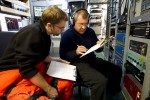
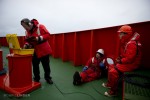
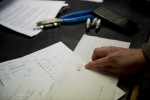
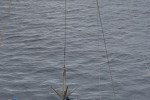
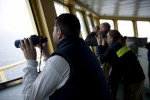

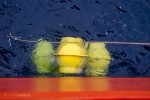

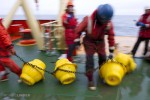










8 Responses to “The Day That Lasted Two Days”